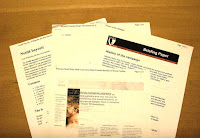If Fish Could Draw II: Reflecting Spheres and the Search for Old Paintings

In September 2009 I blogged about how the limitations of one media often drive creativity in another ( If Fish Could Draw , 28 September 2009). One of the examples I gave was the art of Catarina Kruusval , whose illustrations are sometimes drawn with distorted verticals and perspective like the view from a fisheye lens. I am still convinced that she was inspired by wide angle lenses but it turns out I was rash to say that this view had never been seen until such lenses were invented. Artists have, in fact, been looking at this kind of perspective since they first made metal spheres shiny enough to reflect a wide angle image. There is a famous picture of MC Escher holding a shiny sphere in his hand and observing the reflected image; he used this sphere in the 1920’s and 1930’s to make woodcuts and lithographs where he was at the center. I will be very surprised if nobody thought of this before Escher. One earlier example is a photograph taken in 1910 by an unknown amateur...

